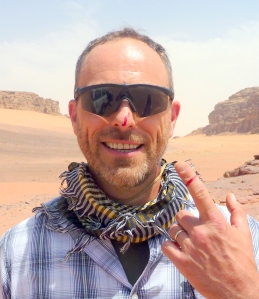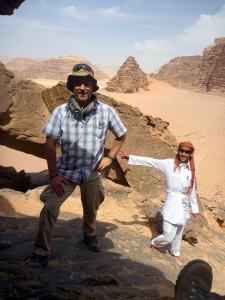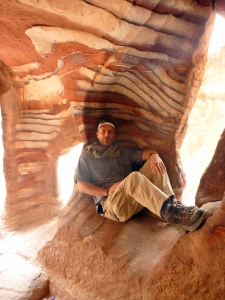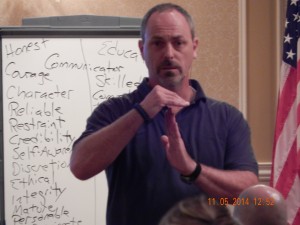Category Archives: Police Dynamics
I have been home on extended leave for almost two months now and have been so caught up in family events, reconnecting with old friends, working on my Masters, and getting ready for my next deployment, that I have totally neglected the blog. However, I hope to get some more training videos posted as early as next week.
In the meantime, one of the officers that worked for me at the Summerville Police Department years ago tracked me down the other day and had some real nice things to say about me and the training he received. During that time, Police Dynamics had not yet been developed as a curriculum, but I was still promoting many of the principles. Plus I provided some defensive tactics training to the officers as well.
Earl Worsham was a “cops cop!” He was the one I sent into the high-crime areas like Brownsville to clean out the criminal element. For those of you who have attended a Police Dynamics seminar, you may remember the story about Brownsville that I tell in the Dynamic of Relationships. Crime was so high there that the Post Office would not deliver mail! Rain, snow, sleet, the dark of night, would not stop the US Mail. But Brownsville stopped it!
Earl was tough and effective. But in spite of his toughness, he understood the importance of building trust-based relationships in the communities where he patrolled. He became somewhat of a folk-hero in Brownsville, earning the affectionate title of “Cowboy” by the locals. I thought you might like to read his comments to me, which I post here with his permission:
I was saying how proud I am of your accomplishments, and how thankful I am to have had the privilege to serve under you in Summerville. I wish I had followed you. I can’t underestimate the value of your support as I relentlessly pursued the criminal element. I want you to know that I was so proud to be a police officer and that your training was the foundation of any sucess that I had.
I knew your expectations and professionally I can honestly say that I stayed within those bounds. You taught me how to conduct myself as an officer, and how to defend myself in my contact with deadly criminal forces. I can’t begin to tell you the times I faced deadly situations that could have went bad without the knowledge you bestowed upon me. It was never the same after you left for me. I will always miss it and will always be a cop in my heart. I hope I did some good.
God bless you and keep you, Ray Nash.
Earl Worsham
Earl, you did a bunch of good! And the lessons we learned working in areas like Brownsville will live on to encourage others…
The long awaited video of me getting thrown off of my camel!
Keep an eye on the camel on the left. We nicknamed him Clyde in honor of the song by Ray Stevens. He was cantankerous from the word go. The camel herder told us he was a Saudi Arabian camel and they have the worst attitudes. Watch what happens as I try to get off of my camel who is tied to Clyde…
Sorry for the long delay in posting. I have been home on extended leave and just too busy spending time with family and friends…!
Here’s another post from my trip to the Holy Land. This one was done on camel-back in the Wadi Rum desert of Jordan. Scroll down to the second video to see me try to do this segment in the middle of a sandstorm. Next I’ll be posting the one where you see me getting thrown off my camel…!
Sir Robert Peel founded the London Metropolitan Police on nine basic principles. Principle number 7 states that “the police are the public and the public are the police.’ Which is another way to define Coactive Policing. Take a look at how this principle applies to law enforcement today…
Here’s me trying to tape this blog in the middle of a windstorm in the Wadi Rum desert of Jordan. You can see that I didn’t have much success. But I never lost my hat…!
I used the opportunity of our jeep tour in Wadi Rum to illustrate the principle of Four Wheel Drive Policing.
Coactive Policing can be compared to a four wheel drive vehicle. When all the wheels are pulling together in the same direction, the vehicle can cover some difficult terrain. In the same way, a community that pulls together can overcome many community problems related to crime, fear of crime, and neighborhood decay and disorder.
One wheel represents law enforcement and local government. The other three represent the other components of the community – the business sector, the academic sector, the faith-based sector, and the citizens themselves. That’s why I am so supportive of the Character Cities initiative because it brings all of these community sectors together to work toward common goals in a coactive manner.
My apologies to my faithful viewers (both of you) for not posting any training videos for a while. I’ve been real busy over here dealing with a number of issues in country (you may have read or heard about some of them) and getting ready for my End of Mission Leave in a few days…!
But here is another training video from our trip to the Holy Land. I hope you enjoy it…
 The word character comes from a Latin word that means “engraved mark.” It also has the meaning of “symbol or imprint of the soul.” And if you think about it, it’s our character that leaves a lasting mark on others. It is our character that is our legacy.
The word character comes from a Latin word that means “engraved mark.” It also has the meaning of “symbol or imprint of the soul.” And if you think about it, it’s our character that leaves a lasting mark on others. It is our character that is our legacy.
On our tombstones will be an engraved mark that records our date of birth, followed by a dash, and our date of death. Our life is summed up by the life we live within the dash. Our character will determine what kind of mark we leave on the lives of others.
The engravers at Petra knew how to leave a mark that would last. Do you…?
Shobak Castle, the first Crusader castle in the nation of Jordan, presented a great opportunity to talk about criminal strongholds. Our driver, Ashrf (pronounced Ashraff) from Jordan Beauty Tours took us off-road to a hill overlooking this site while we were on our way to Petra. The wind presented a bit of a challenge to the audio, so my faithful cameraman and travelling partner, Gary Curry, suggested we move off of the hill onto a ledge just below. It cut the wind noise some, but as you can hear, I still had to compete with it…
 Just like the Crusaders of the early 12th century used Shobak as a base of operations to control the surrounding countryside, criminals will use a stronghold that they have created to invade surrounding neighborhoods and expand their territory (not to compare Crusaders with criminals, but you get the point). Just like playing chess on a giant chessboard, this is how criminals are gaining ground on us in America (and other countries) today.
Just like the Crusaders of the early 12th century used Shobak as a base of operations to control the surrounding countryside, criminals will use a stronghold that they have created to invade surrounding neighborhoods and expand their territory (not to compare Crusaders with criminals, but you get the point). Just like playing chess on a giant chessboard, this is how criminals are gaining ground on us in America (and other countries) today.
The ineffectiveness of Reactive Policing can be illustrated by how we respond to crimes committed by criminals who venture out from the stronghold into other neighborhoods. We find ourselves rushing from call to call: go to a call, take a report – go to the next call, take a report – go to the next call, take a report… Interestingly, as we chase our tails in this endless cycle of reactivity, we start to measure our effectiveness not by what we did to solve the problem that generated the call, but by how long it took us to get there!
Criminal strongholds and the cycle of reactivity can only be broken by coactively attacking the Fear, Apathy, and Tolerance for crime that allows strongholds to exist. How do we do this? Through community relationships that are fueled by trust and powered by the character of police officers who are properly aligned under authority…
 I’m back from the Holy Land and can’t wait to share some of my adventures. My luggage had such a good time that it decided to stay…! So, I can’t post any of the video blogs I made while I was there just yet because the cables to connect the video camera to the computer are in the bags…
I’m back from the Holy Land and can’t wait to share some of my adventures. My luggage had such a good time that it decided to stay…! So, I can’t post any of the video blogs I made while I was there just yet because the cables to connect the video camera to the computer are in the bags…
But I had a pleasant surprise when I got back to Afghanistan. A dear friend of mine had sent me the book More Than Enough by Dave Ramsey, the popular financial guru. I’ve enjoyed listening to Dave on the radio for years but had never read any of his books. I was pleasantly surprised to find that this book is more about character than it is finances!
 In one section entitled Responsibility Has to Be Personal, Dave has this to say:
In one section entitled Responsibility Has to Be Personal, Dave has this to say:
Albert Schweitzer said it well: “Man must cease attributing his problems to his environment, and learn again to exercise his will, his personal responsibility.” Enough whining, I am sick of whining, whining by every special interest group, whining against our upbringing, whining against the mean old boss, whining against your pastor, whining about your spouse – especially if it’s an ex-spouse – just whining. Whining is a sign of a lack of character on your part. If you don’t like the way something is, do something about it. Finger-pointing, blame shifting and whining, while they appear to have merit, are not doing something. There is tremendous energy in positive activity and in providing a solution. That activity, while it may not solve the problem, moves you from being self-centered to being solution-centered. (emphasis added)
This principle is in keeping with the Dynamic of Restoration which identifies five progressive steps on the Path of Destruction. When someone steps out from under authority and develops anIndependent Spirit, the walls of hostility go up and they begin to deflect the truth by assigning blame. This leads to a Wounded Spirit where the person’s feelings get hurt so easily.
We see this all the time in law enforcement: “He got a new winter jacket and I didn’t get one…” “She got a new patrol car assigned and I was next in line for a new car…” “He got the promotion and everybody knows I should have been the one to get it…” And on and on and on. A Wounded Spirit can lead to bitterness, which is even more destructive.
We will explore these principles in more detail in future blogs. In the meantime, keep up the good character…!
Sheriff Ray
There are three things that must be present in a community for a criminal stronghold to exist: fear, apathy, and tolerance for crime. The criminal knows that if he can intimidate the citizens, he has a toehold in the stronghold. If he drives through the community and sees overgrown lots, graffiti, abandoned homes, broken-down cars, and litter everywhere, it sends a message that the community does not care about itself. And if the community tolerates crime, it will have crime. This is a fundamental truth. Interestingly, it will have just as much crime as it is willing to tolerate.
Coactive policing is about building a trust-based partnership with the community, and then applying the power of that relationship to attack the fear, apathy, and tolerance for crime that allows a criminal stronghold to exist.
Shoot me an email at ray@policedynamics.com and I will send you a report called CRASHing the Gates of the Stronghold that outlines a practical plan for coactively reducing crime in problem neighborhoods (but give me a few days because I’m about to leave for a vacation…).
By definition, criminals operate “out from under authority.” And they’re constantly trying to get the police to step out there with them. They will push every button you’ve got until they get you to react to them out of your own pride and ego. And once you step out into their territory, they’ve got you right where they want you.
It’s the classic challenge to a police officer’s authority. You’ve all heard it. It goes something like this: “You wouldn’t be so tough if you took that badge off!” Regretfully, some officers will figuratively take their badge off and answer the challenge. A few of them will literally take their badge off and engage the criminal at their level.
To resist this challenge, remember what you represent: the law, the Constitution, the agency, your Chief or Sheriff, the standards of the police profession. Ultimately, you represent the people. The one thing you don’t represent is yourself. And the minute you think that you are out there to represent your goals, your agenda, and your ego, is the minute you set yourself up for a major ethical failure. This is the fundamental teaching of the Dynamic of Authority, the cornerstone of the Police Dynamics program. Watch this video on the Independent Spirit for more information.
Operating under authority is essential to building trust and accomplishing the police mission. It means: if the criminal is pushing your buttons, make sure you don’t have any buttons without “button covers…!”
The Dynamic of Authority is the essential teaching to understanding the Police Dynamics training series and principles of character-based leadership. Here, I use it as a teaching paradigm to communicate how to model a standard of good character. If the leadership of an organization is not modeling good character as well as encouraging it, the whole process breaks down.
Understanding what the badge actually represents and the proper relationship between a police officer and his or her authorities is perhaps the most important teaching for law enforcement personnel and their leaders to grasp.









